Letters from Lodi
An insightful and objective look at viticulture and winemaking from the Lodi
Appellation and the growers and vintners behind these crafts. Told from the
perspective of multi-award winning wine journalist, Randy Caparoso.
How the Autumnal Equinox whets our appetite and thirst for red wines
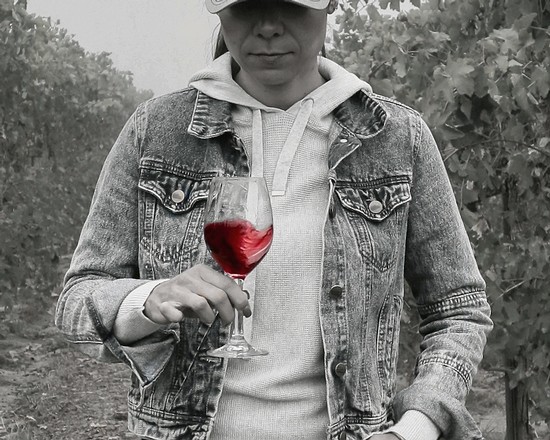
Vineyard tasting on the cusp of autumn, Lodi's Mokelumne River appellation.
I don't know if you noticed, but last Saturday summer quietly slipped out the proverbial backdoor, making way for fall of 2023. September 23 marked the Autumnal Equinox, when the sun veered over the equator, causing the day to last approximately the same amount of time as night. Henceforth, daylight hours will shrink by about a minute each day, until Winter Solstice (December 22), the shortest day of the year.
The other day I heard someone describe this time of year as the "brrrr" period. There will be some times when we're not quite prepared for the sudden nip in the weather; especially at night, because most of us wait until we can't take the shivering under the sheets anymore, before reluctantly clicking on the heater (sending our utility bill skyrocketing once again).
Hate to say it, but 2023 The Old Farmers Almanac (which has been advising citizens since 1818) is giving the West Coast a succinct yet dour prediction for this autumn: "Below normal temperatures with increasing precipitation." Keep those puff jackets and waterproof shoes handy.
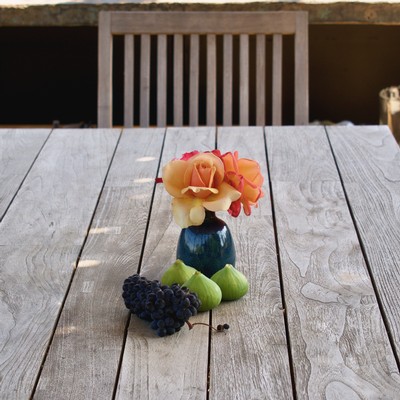
Autumn table setting in vineyard.
Reds from Mars, whites from Venus (rosés from somewhere between)
If you're like me, you drink red wine through winter, spring, summer and fall. Since I prefer red wine to whites or rosés, it's more a matter of mixing a few bottles of whites or rosés with reds during the hotter months, and eliminating them completely during the colder months. Isn't real wine red?
It makes sense, of course, to drink whites and rosés during the hottest months because these wines are served cold, and the body enjoys a chilled beverage. But since I prefer reds, my solution has always been to serve myself reds that are little chilled. It also helps to focus on red wines with softer tannin that are lighter in alcoholic weight and oak qualities—the kind of red wines that taste better when chilled, instead of at room temperature.
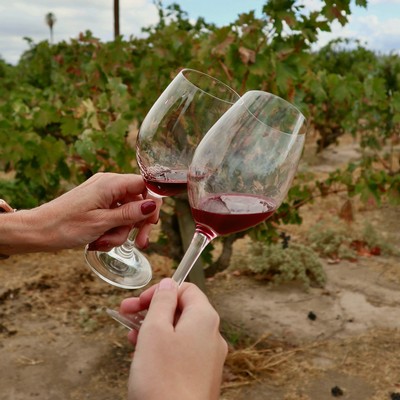
Tasting ancient vine Mokelumne River-Lodi Zinfandel in the vineyard where it's grown.
The body, however, is also instinctively more conducive to red wines starting in the autumn months because of the simple biological differences between whites, rosés and reds. Broadly speaking, between the three major types of table wine:
1. White wines are made from pale green or gold colored grapes that have had their skins removed as soon as they hit the winery, and it is just their juice that is fermented. The result is white wines are typically more floral and citrusy in their fragrances, and fruit qualities veer towards orchard varieties (apple, pear, peach, etc.). On the palate, the taste of tannin or bitterness is minimal—sensations are driven primarily by levels of acidity (especially citrus-like qualities) and alcohol (giving white wines weight, whether a light feeling 12% ABV or heavier tasting 14% ABV).
2. Rosés are made from darker colored red wine grapes; only, their juice is immediately pressed off the grape skins when delivered to the winery (pale pinkish amounts of pigment are retained from the grapes' dark skin), and consequently the wine is fermented and handled pretty much like white wines. Therefore, like white wines, rosés taste crisp or citrusy on the palate. What makes them different from white wines is that they tend to have aromas or fragrances that strongly suggest fruits in red berry spectrums (cherry, strawberry, raspberry, plum, watermelon, etc.), with less of the lemon or citruses common to white wines. Like white wines, of course, you drink rosés nice and cold, but they're obviously different because their fragrances and flavors vaguely suggest red wines—not surprisingly since they are made from the same grapes utilized for red wines.
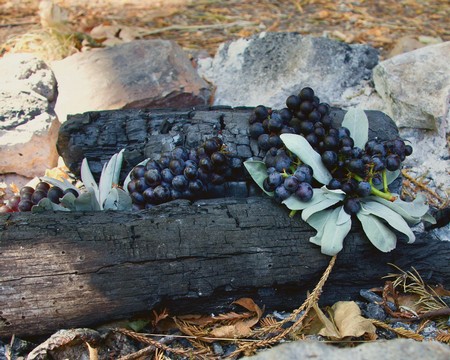
2023 grapes on charred wood.
3. Red wines are made from black skinned grapes that are fermented with their skins kept intact. Many wineries simply destem the grapes and ferment the berries whole, without "crushing" them. For small handcraft production, some wineries don't even bother to destem—they ferment red wines from batches of whole clusters, stems and all. The basic idea is that color is retained from skins, and phenolic content—primarily tannin, a naturally bitter component—adds to a sense of body and density not typically found in white wines or rosés. Red wine aromas tend to fall in the berry spectrums, similar to that of rosés, but are much deeper, or more pungent, especially when manifested on the palate, with their taste much more savory.
Because of their bitter components, it is never a good idea to drink red wines ice-cold like you can with whites and rosés. When served too cold, the aromas (and hence, the flavors) of red wine tend to be locked in, and the bitterness of tannin is heightened. However, the fruit qualities of most red wines can be enhanced by giving bottles a slight chill; say, about 60° or 65°, which you can get after just 30 to 60 minutes in a fridge.
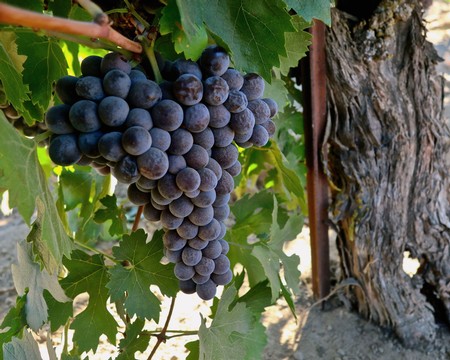
Ancient vine Cinsaut (planted in 1886) in the heart of Lodi's Mokelumne River region.
The umami—and red wine—time of year
You drink reds in autumnal months because there is less of a thirst for icy cold wines, but also because of seasonal, food-related and mental inclinations: Autumn is a natural time of year for heartier dishes and, say, pungently spiced berry pies. That feeling, or appetite, is practically in the air. On a sensory level, the tannin in red wines are more conducive to the fatty taste of meats and the complex melange of flavors cooked into stews or made into sauces, and the aromas specific to most red wines are simpatico with many of the fruits associated with autumn. This is not rocket science—the mind and body want what they want.
But there is one factor that is typically overlooked, making red wines more appropriate for the brrrr-time of year, and that factor is called umami.
You can find a ton of information on umami online, but insofar as its repercussions in the context of wine, the most thorough introduction to this taste component can be found right here on this page (re Deconstructing umami in wine and food contexts). Why? Because we make it our business to understand the role of umami, especially in red wine grapes—the staple product of Lodi's winegrowing industry—and since umami is something more likely to be found in red wines, rather than whites or rosés
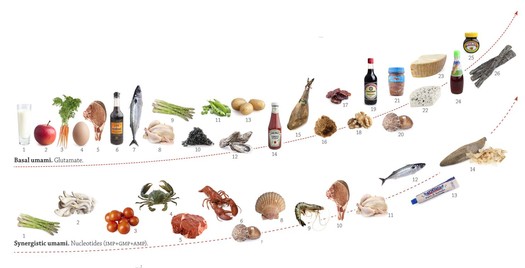
Umami-rich "chain of foods" (image from Umami by Ole G. Mouritsen & Klavs Styrbaek)
Heck, we've even come out with a recent blog on the newly opened Lodi Bowling, in which umami plays a huge part in the way our local bowling alley's menu was designed and its red wines were selected.
What is umami and why should you care? First, umami is essentially a savory taste, utilized throughout the food industry to enhance the other four basic tastes (i.e., sweet, sour, bitter and salty). Asians like to add "spicy" or "hot" as still another basic taste, which is why many Asian dishes are deliberately prepared to balance sweet, sour, bitter, salty, hot as well umami sensations.
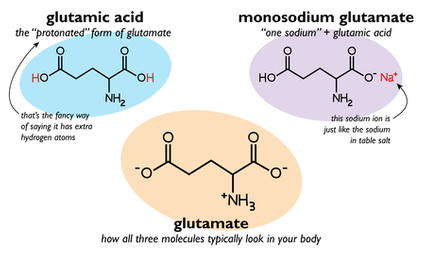
Free glutamate molecules occurring naturally in foods that bind with umami-sensitive taste buds, creating savory sensations on the palate.
Second, umami occurs in the presence of high amino acid components, also often referred to as glutamates. You literally perceive glutamates as savory, the way sugar tastes sweet and lemon tastes tart. A lot of people mistakenly assume that this mean monosodium glutamate (i.e., MSG), but that particular artificial flavor booster is just one of countless examples of the way glutamates are utilized to enhance the savory sensation associated with umami. Glutamates, in fact, occur naturally in numerous foods that we consume practically every day.
For instance, our favorite aged cheeses—Parmigiano, Manchego, Gouda, blue veins, et al.—are all deliberately crafted to attain high amounts of umami, or glutamates, which are precisely what makes those cheeses special. Softer cheeses that see no aging (Brie, chèvre, mozzarella, etc.) are typically consumed when young and therefore are much lower in glutamates, thus lower in umami.
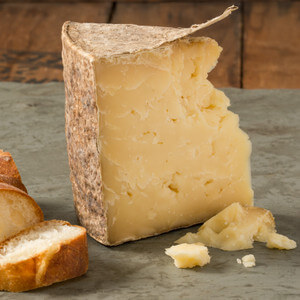
Modesto's Fiscalini Bandaged Cheddar. farmstead.biz.
Hence the crunchy, complex flavors typifying, say, a classic aged cheese such as Fiscalini's Bandaged Cheddar, aged 18 to 30 months to develop its famously savory flavors. The aging process involved in the making of a product like this obviously does not involve MSG. It is a matter of incurring naturally intense levels of glutamates. The end result is a concentration of umami perceptions, making a Fiscalini Bandaged Cheddar that much more desirable to cheese lovers.
Another everyday instance in which umami is utilized to boost the taste of dishes is with Parmigiano. Whenever we have a plate of pasta with a tomato sauce of some sort—with meat, without meat, with morsels of vegetables or no vegetables at all, it doesn't matter—for almost everyone that plate of pasta is not complete without a heavenly shower of grated Parmigiano. This is because Parmigiano is such a powerful source of amino acids or glutamates. Simply put, it makes pasta in tomato sauce taste so much better.
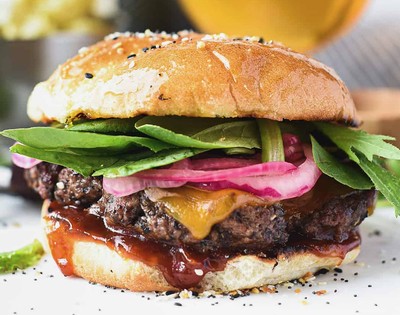
An "Ultimate Umami Burger," replete with glutamate-rich ingredients. supermancooks.com.
Still another everyday example of the use of umami: Ketchup, mustard and cheddar cheese in burgers. These are all high umami ingredients which, therefore, taste great when put all together. Combined with fatty beef, they make an explosion of savory sensations—no wonder many restaurants now come out and list their burgers as "umami bombs." Most American may not have thought of themselves in this way, but they grew up as connoisseurs of umami.
Then there is the civilized, centuries-long custom of enjoying wines with cheeses. Sooner or later, most wine lovers who have cultivated a knowledge or affection of the great cheeses in the world also come to this natural conclusion: Soft ripened cheeses generally taste best with white wines or rosés, whereas aged cheeses generally taste best with red wines.
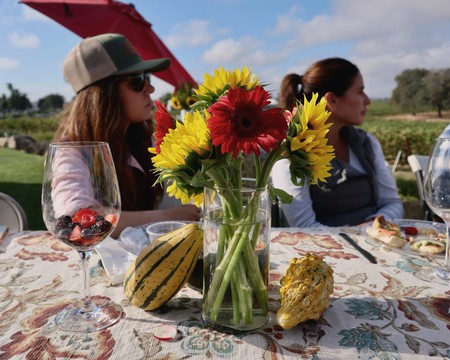
Autumnal table in Lodi's Clements Hills appellation.
Most of us know this instinctively. It doesn't matter whether you are aware of it or not, but the reasons we come to these natural conclusions are pretty cut-and-dried:
• Since the taste of softer, younger cheeses are defined by their levels of creaminess and natural acidity, it is the softer textured, citrusy qualities of white wines or rosés that are more likely to compliment these cheeses.
• Since the taste of aged cheeses are defined by the savory qualities attained by the aging process, it is the more savory qualities of red wines—which derive their higher levels of amino acids from grape skins (remember, red wines are fermented with skins, and whites and rosés without skins)—that are more likely to taste best with these cheeses.
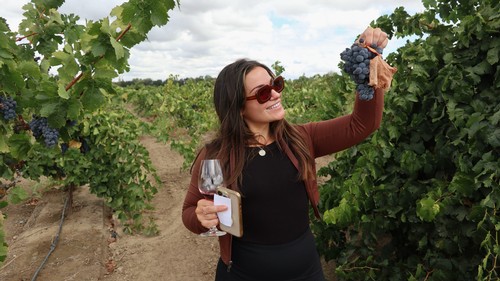
Experiencing ancient vine Carignan (in vineyard over 100 years old) in Lodi's Mokelumne River AVA.
"Cut-and-dried" is not to be confused with "hard-and-fast." Some people put ketchup on their eggs or pour orange juice in their cereal—there is no accounting for taste. If you prefer a dark, heavy, oaky Cabernet Sauvignon with chèvre, or a tart, effusive, oak-free Sauvignon Blanc with 3-year aged Gouda, knock yourself out. But generally speaking, most people prefer the opposite—Cabernet with Gouda, Sauvignon Blanc with chèvre. Red wines are more savory because of their amino acid content, which is why they are more likely to compliment aged cheeses or any foods that are higher in umami-rich ingredients.
This, of course, goes far beyond cheeses. Elevated doses of umami occur naturally in many foods, from sun ripened tomatoes and mushrooms to onions, the full range of shellfish, grilled meats and long simmering stocks, stews, braises and sauces. That is to say, many of the foods—not coincidentally, higher in umami—associated with seasons when days are shorter and nights are... brrrr.
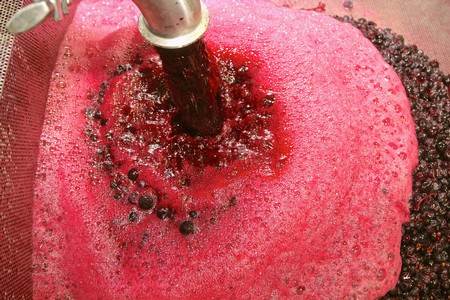
Lodi Zinfandel pump-over, mixing juice with skins during fermentation, deepening the savory components of the wine.
Everything, this time of year, is connected:
• Autumn weather stimulates cravings for heartier foods with higher umami.
• Heartier foods stimulate cravings for more red wines.
• Red wines are higher in umami, therefore more likely to compliment autumnal, umami-rich foods..
But you probably already knew all of this, without having to read or talk about it.
Enjoy your autumn season!
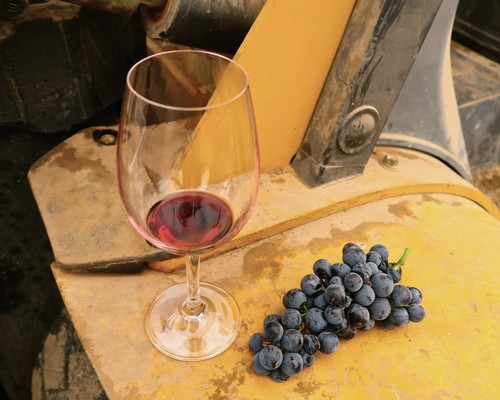
Autumnal tasting of Syrah on tractor in Mokelumne River-Lodi vineyard.